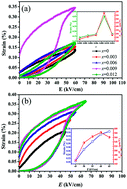High strain in (Bi1/2Na1/2)0.935Ba0.065TiO3–Sr3FeNb2O9 lead-free ceramics with giant piezoresponse
Abstract
The structure, electric field-induced strain (EFIS), polarization and piezoelectric response of lead-free Sr3FeNb2O9-modified (Bi1/2Na1/2)0.935Ba0.065TiO3 (BNBT–xSFN, with x = 0–0.012) ceramics were investigated. XRD patterns show that all compositions have a pure perovskite structure and SFN effectively diffused into the BNBT lattice during sintering to form a solid solution. A large EFIS of 0.35% was obtained at the critical composition of x = 0.009 which corresponds to a normalized strain (Smax/Emax) of 583 pm V−1. A maximum value of piezoelectric constant (254 pC N−1) was obtained for x = 0.006. These results show our research can benefit the developments of Bi1/2Na1/2TiO3 ceramics and widen their range of applications.


 Please wait while we load your content...
Please wait while we load your content...